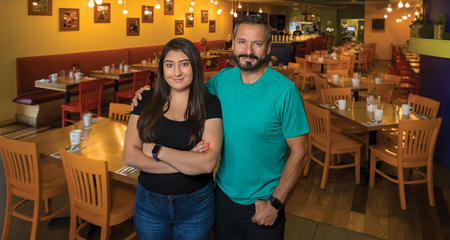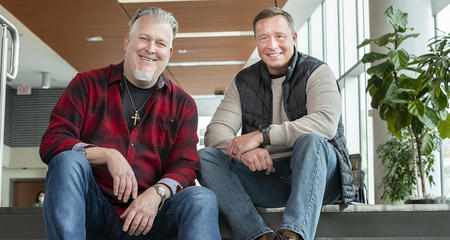
One-Two Punch: Collaborative Treatments Help Mark Beat Two Head and Neck Cancers
After being around cancer care for years, Mark experienced firsthand how specialists with the Froedtert & the Medical College of Wisconsin Cancer Network collaborate to treat cancer.

Mark Krier was certainly no stranger to cancer.
Mark stood by his wife, Paula, as she received care for a rare, aggressive head and neck cancer from physicians with the Froedtert & MCW Cancer Network. After fighting hard for five years, which was deemed a “miracle” by her doctors, Paula passed away in December 2009. About four years later, Mark would need to see some of the same doctors again — this time, for his own cancer.
“It was pretty odd when I went back in,” Mark said. “After Paula fought the good fight for five years, her cancer eventually spread too much. So when I went in and saw the same great chemo and radiation doctors that she had, they were surprised to see me.”
First Cancer Detection
In 2014, the father of two noticed a swollen lymph node in his neck, despite feeling fine. He decided to visit his primary care physician where a biopsy was performed. The biopsy results indicated cancer, and Mark was referred to Michael Stadler, MD, a head and neck surgeon and chief of head and neck surgery, for further care at the Clinical Cancer Center at Froedtert & MCW Froedtert Hospital.
Based on the initial biopsy results, Dr. Stadler had an inkling that Mark had squamous cell carcinoma, which is, fortunately, not rare and can usually be treated successfully. Dr. Stadler performed an outpatient surgical biopsy to collect and further analyze a sample of the primary tumor on the back of Mark’s tongue. The biopsy results confirmed Dr. Stadler’s suspicions and propelled forward the course of treatment he had in mind: chemotherapy and radiation therapy – no surgery.
“We have much more advanced and less invasive technology to address these types of tumors than in the past,” Dr. Stadler said. “The most optimal treatment course is decided after discussion during a multidisciplinary tumor board meeting and involves understanding exactly where the tumor is located, our ability to access it, staging and sometimes, the sheer size of the tumor. All of these factors play a role, and in Mark’s case, treating his tumor with nonsurgical methods was his best option.”
Clinical Trial Explores a New Chemotherapy Treatment
As part of that tumor board, Christopher Schultz, MD, radiation oncologist and chair of radiation oncology, and Stuart Wong, MD, medical oncologist, weighed in on that decision for Mark’s treatment plan. Both doctors treated Mark’s wife and remembered the couple.
“Paula had an unusually challenging tumor,” Dr. Wong said. “Since Mark was at all of her appointments, they left an indelible mark in our minds – particularly because they were young, with small children and had so much at stake. When Mark showed up in our clinics, it first brought back those feelings, so we were relieved to learn that he had a cancer we consider curable, and that we could offer him treatment in a clinical trial, which he graciously agreed to participate in.”
As eastern Wisconsin’s only academic medical center, Froedtert Hospital offers patients the opportunity to partake in clinical trials that can expand treatment options today and help shape the way treatment is provided in the future. This randomized clinical trial, sponsored by the NRG Oncology Head and Neck Committee that is co-chaired by Dr. Wong, compared cisplatin, an older, “tried and true” cancer drug that has various side effects (including hearing loss), against a newer, less-toxic drug, cetuximab. Mark was placed in the cisplatin arm of the trial, which turned out to be the drug that the trial found superior for treating his type of cancer. He responded well to the chemotherapy, which was administered via intravenous injection once before and once in the middle of his other treatment course: intensity-modulated radiation therapy (IMRT).
Intensity-Modulated Radiation Therapy
Compared to conventional radiation therapy, IMRT is a technique that enables the delivery of radiation that conforms to the three dimensional shape of the tumor while also avoiding surrounding organs that are at risk of receiving unnecessary radiation. With the help of 3D images from pre-treatment planning scans, the radiation beam is able to be altered to create multiple cross firing beams that are delivered around the patient’s head and neck region in 360 degrees. When each beam’s dose is added together, a highly effective treatment is produced. This approach decreases common radiation therapy side effects common to head and neck cancers like dry mouth, losing tooth enamel or even losing teeth. Because there are many small organs, glands and tissues in this area, IMRT is the standard of care for head and neck cancers.
With his head and neck immobilized under a plastic mesh mask, Mark received 15–20 minutes of radiation daily for about six week to treat his tongue and lymph nodes’ cancerous cells. Much like he did for his chemotherapy, and with the aid of the targeted nature of IMRT, he avoided many treatment side effects. After about four years of follow-up appointments with imaging scans to monitor any changes that could indicate cancer growth, Mark was declared cancer-free.
“All my scans were coming up clean,” Mark said. “I was told there were no visible signs of cancer and the chances of me having a recurrence were no more than anyone else who hasn’t had it before.”
Second Cancer Detection, Surgery and Recovery
Mark’s squamous cell cancer never recurred. Instead, in early 2018, Mark felt and saw a bump on the roof of his mouth. Realizing it didn’t feel normal, Mark brought it up during his scheduled appointment with Dr. Schultz a week later. Dr. Schultz referred Mark back to Dr. Stadler for a biopsy, and pathology showed that Mark had a new, unrelated type of cancer, called mucoepidermoid carcinoma. Fortunately, it was detected in an early stage and could be removed surgically. In May 2018, Dr. Stadler performed surgery to remove the cancerous tissue.
“Because we caught it early, Dr. Stadler decided to remove it surgically and monitor it closely,” Mark said. “Surgery was in the morning, and since it went so well, I had the option to stay or go home. I figured that I’ve been in hospitals enough already in my life, so I went home and followed instructions to rest up.”
Since the surgery, Mark’s follow-up appointments with his doctors and physician assistants have gone well, and he has been living free of cancer. Thanks to the collaborative care of his team, he is back to enjoying cycling (even participating in an annual race with Dr. Wong) and overseeing his church’s Friday night fish fry. He’s grateful for the care he received and recommends Drs. Stadler, Wong and Schultz to anybody needing cancer care.
“There’s something about their knowledge, demeanor, calmness and confidence in what they’re doing,” Mark said. “They’re all so friendly and genuinely make you feel like you are their only patient.”
What to Watch Out For and How We Can Help
If you notice a new lump or bump on your neck, in your mouth or throat, our physicians implore you to seek care right away through your primary care physician, or with a Froedtert & MCW health network ear, nose and throat specialist. This team of physicians works closely with other specialties to deliver research-based, multidisciplinary care for common and uncommon cancers.
“Not only do we have our own disease-specific focus for head and neck cancer, we constantly talk with one another and make sure we are all aligned in the patient’s best interest,” Dr. Stadler said. “Mark had the intuition to say ‘something’s not right here’ and get checked out not once, but twice. Those are the sort of decisions that save lives.”


